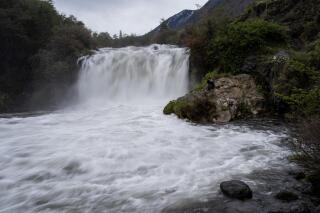Saving sacred rivers

Ruben Onate takes pictures sitting next to the largest waterfall of the Truful Truful River, near Melipeuco, southern Chile, on Thursday, June 30, 2022. Mapuche people believe in the falling water’s distinctive “energy power” for healing purposes, either in riverside ceremonies or by taking large soda bottles full of it back home. (AP Photo/Rodrigo Abd)
Around the world, over millennia, rivers have provided wondrous gifts – nourishment, mobility, irrigation, natural beauty.
In acknowledgement of those gifts, some cultures consider the rivers of their realms to be sacred – beseeching them with prayers, partaking of their waters for joyous and somber rituals.
Today, even as these rivers remain an object of devotion, some face dire threats – severe pollution, diminution of their flow, hydroelectric projects. In Nepal, many devout Hindus no longer cleanse the bodies of their newly deceased loved ones with the waters of the Bagmati River – it’s befouled by sewage. In the Middle East, the Jordan River’s dwindling waters are a dull greenish brown as they approach the site revered as where Jesus was baptized.
The Associated Press explores the challenges facing the Bagmati, the Jordan and sacred rivers in four other far-flung regions of the world.
In 2017, New Zealand passed a groundbreaking law granting personhood status to the Whanganui, which is revered by the Māori people. The Associated Press followed the river upstream to find out what its status means to those whose lives are entwined with its waters. For many, its enhanced standing reflects a wider rebirth of Māori culture and a chance to reverse prolonged degradation of the river.
The Columbia has sustained Indigenous people in the Pacific Northwest for millennia. The river’s salmon and the roots and berries that grow nearby are known as “first foods” because of the belief that they volunteered to sacrifice themselves for the benefit of humans. Today, the foods and the river are threatened by industrialization, climate change and pollution.
Nepal’s most sacred river is also its most polluted. In the capital, Kathmandu, raw sewage is dumped directly into the Bagmati, and heaps of garbage are tossed in from the banks. Once sparkling and clear, the river’s waters are black and sludgy, undrinkable and unsuitable for even cleaning.
Symbolically and spiritually, the Jordan River is of mighty significance to many as the scene of miracles and the place where Jesus is said to have been baptized. Physically, today’s Jordan is more meager than mighty. Its dwindling waters run sluggish, a dull shade of greenish brown, by the time it reaches the area of Jesus’ baptism.
The Osun River flows through a forest designated as a UNESCO World Heritage Site. It is revered by the Yoruba-speaking people of southwestern Nigeria. But it’s under constant threat of pollution from waste disposal and other human activity. That includes dozens of illegal gold mines whose runoff fills the river with toxic metals.
For the Mapuche, Chile’s largest Indigenous group, a pristine river like the Truful Truful, flowing from a lava field under an Andean volcano, is the home of a spiritual force to revere, not a natural resource to exploit. Thus many Mapuche communities across the country’s water-rich south are fighting hydroelectric plants that they see as desecrating nature.
Associated Press religion coverage receives support through the AP’s collaboration with The Conversation US, with funding from Lilly Endowment Inc. The AP is solely responsible for this content.
